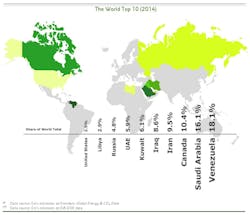World oil and gas reserves in 2014 showed slight growth, highlighted by reserves additions in the US in the form of tight oil, according to Eni SPA’s 14th edition of its World Oil & Gas Review, an annual statistics report on world oil and gas reserves, production, and consumption.
The US entered the top 10 of oil reserves holders for the first time and continued its rise among gas reserves holders.
World oil production increased 2.2%, the most significant rise in the last 10 years, concentrated in countries outside of the Organization of Petroleum Exporting Countries. The US surpassed both Saudi Arabia and Russia, jumping a record 15.4% to become the top oil producer in the world thanks to tight oil.
Canada ranked as the fourth-most proficient oil producer while China dropped to fifth. Notably, Iraq rose 8.1% and Iran posted growth of 4.7%. In Libya, output plummeted back to 2011 levels.
Global oil demand growth in 2014 slowed to 0.7%. Countries within the Organization for Economic Cooperation and Development returned to their structural decline pace of 1%, but with different paths on either side of the Atlantic Basin. The US continued to grow, posting a 0.4% rise, while European countries lost ground with another year of contraction, falling 1.4%.
Non-OECD countries led the growth at 2.5% and overtook OECD countries in terms of oil consumption. China remained the driving force albeit at a slower rate, rising 3% in 2014 vs. the 5.9%/year averaged from 2000 to 2014.
Global gas production remained flat, led by the US, which confirmed its position as the top producer for the 3rd consecutive year thanks to shale gas. Russia, the world’s second-most proficient gas producer, saw output fall 6.1%, reflecting both declining domestic demand and contracting exports, Eni says.
World gas consumption registered a modest decrease in 2014 at 0.4% vs. an increase of 2.4%/year averaged from 2000 to 2014. Mild weather and economic weakness drove gas demand reductions in Europe and Russia.
In the Middle East and Asia-Pacific regions, gas consumption increases were driven by economic growth, especially in Iran and China. The vast availability of domestic gas production and low prices supported US consumption growth, confirming the country’s position as the biggest gas consumer in the world, Eni says.



